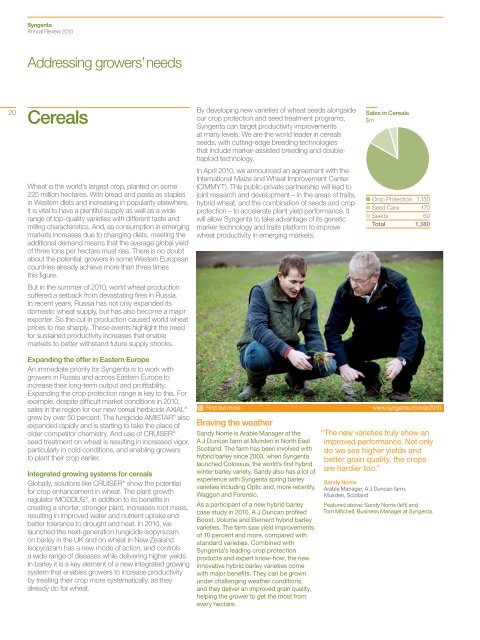Syngenta Annual Review 2010 - CEO Water Mandate
Syngenta Annual Review 2010 - CEO Water Mandate
Syngenta Annual Review 2010 - CEO Water Mandate
Create successful ePaper yourself
Turn your PDF publications into a flip-book with our unique Google optimized e-Paper software.
<strong>Syngenta</strong><br />
<strong>Annual</strong> <strong>Review</strong> <strong>2010</strong><br />
Addressing growers’ needs<br />
20<br />
Cereals<br />
By developing new varieties of wheat seeds alongside<br />
our crop protection and seed treatment programs,<br />
<strong>Syngenta</strong> can target productivity improvements<br />
at many levels. We are the world leader in cereals<br />
seeds, with cutting-edge breeding technologies<br />
that include marker-assisted breeding and doublehaploid<br />
technology.<br />
In April <strong>2010</strong>, we announced an agreement with the<br />
International Maize and Wheat Improvement Center<br />
(CIMMYT). This public-private partnership will lead to<br />
joint research and development – in the areas of traits,<br />
hybrid wheat, and the combination of seeds and crop<br />
protection – to accelerate plant yield performance. It<br />
will allow <strong>Syngenta</strong> to take advantage of its genetic<br />
marker technology and traits platform to improve<br />
wheat productivity in emerging markets.<br />
Sales in Cereals<br />
$m<br />
Wheat is the world’s largest crop, planted on some<br />
225 million hectares. With bread and pasta as staples<br />
in Western diets and increasing in popularity elsewhere,<br />
it is vital to have a plentiful supply as well as a wide<br />
range of top-quality varieties with different taste and<br />
milling characteristics. And, as consumption in emerging<br />
markets increases due to changing diets, meeting the<br />
additional demand means that the average global yield<br />
of three tons per hectare must rise. There is no doubt<br />
about the potential: growers in some Western European<br />
countries already achieve more than three times<br />
this figure.<br />
But in the summer of <strong>2010</strong>, world wheat production<br />
suffered a setback from devastating fires in Russia.<br />
In recent years, Russia has not only expanded its<br />
domestic wheat supply, but has also become a major<br />
exporter. So the cut in production caused world wheat<br />
prices to rise sharply. These events highlight the need<br />
for sustained productivity increases that enable<br />
markets to better withstand future supply shocks.<br />
Crop Protection 1,150<br />
Seed Care 170<br />
Seeds 60<br />
Total 1,380<br />
Expanding the offer in Eastern Europe<br />
An immediate priority for <strong>Syngenta</strong> is to work with<br />
growers in Russia and across Eastern Europe to<br />
increase their long-term output and profitability.<br />
Expanding the crop protection range is key to this. For<br />
example, despite difficult market conditions in <strong>2010</strong>,<br />
sales in the region for our new cereal herbicide AXIAL ®<br />
grew by over 50 percent. The fungicide AMISTAR ® also<br />
expanded rapidly and is starting to take the place of<br />
older competitor chemistry. And use of CRUISER ®<br />
seed treatment on wheat is resulting in increased vigor,<br />
particularly in cold conditions, and enabling growers<br />
to plant their crop earlier.<br />
Integrated growing systems for cereals<br />
Globally, solutions like CRUISER ® show the potential<br />
for crop enhancement in wheat. The plant growth<br />
regulator MODDUS ® , in addition to its benefits in<br />
creating a shorter, stronger plant, increases root mass,<br />
resulting in improved water and nutrient uptake and<br />
better tolerance to drought and heat. In <strong>2010</strong>, we<br />
launched the next-generation fungicide isopyrazam<br />
on barley in the UK and on wheat in New Zealand.<br />
Isopyrazam has a new mode of action, and controls<br />
a wide range of diseases while delivering higher yields.<br />
In barley it is a key element of a new integrated growing<br />
system that enables growers to increase productivity<br />
by treating their crop more systematically, as they<br />
already do for wheat.<br />
Find out more<br />
Braving the weather<br />
Sandy Norrie is Arable Manager at the<br />
A J Duncan farm at Muirden in North East<br />
Scotland. The farm has been involved with<br />
hybrid barley since 2003, when <strong>Syngenta</strong><br />
launched Colossus, the world’s first hybrid<br />
winter barley variety. Sandy also has a lot of<br />
experience with <strong>Syngenta</strong> spring barley<br />
varieties including Optic and, more recently,<br />
Waggon and Forensic.<br />
As a participant of a new hybrid barley<br />
case study in <strong>2010</strong>, A J Duncan profiled<br />
Boost, Volume and Element hybrid barley<br />
varieties. The farm saw yield improvements<br />
of 10 percent and more, compared with<br />
standard varieties. Combined with<br />
<strong>Syngenta</strong>’s leading crop protection<br />
products and expert know-how, the new<br />
innovative hybrid barley varieties come<br />
with major benefits. They can be grown<br />
under challenging weather conditions,<br />
and they deliver an improved grain quality,<br />
helping the grower to get the most from<br />
every hectare.<br />
www.syngenta.com/ar<strong>2010</strong><br />
“The new varieties truly show an<br />
improved performance. Not only<br />
do we see higher yields and<br />
better grain quality, the crops<br />
are hardier too.”<br />
Sandy Norrie<br />
Arable Manager, A J Duncan farm,<br />
Muirden, Scotland<br />
Featured above: Sandy Norrie (left) and<br />
Tom Mitchell, Business Manager at <strong>Syngenta</strong>.











